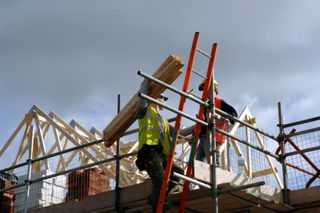What is the Building Safety Act and how can it affect your project? Here's what you need to know...
Here we look at the implications of the Building Safety Act, such as what its key measures are, why the act was introduced and who the act applies to

The Building Safety Act has introduced reforms to strengthen the rights of homeowners to make homes across England and Wales safer.
The act overhauls currentbuilding regulationsand creates an array of measures for constructing, upkeeping, and ensuring the safety of residential structures, and holds those accountable for any defects.
The aim is to provide the homebuilding industry with a transparent and balanced framework, allowing for the creation of more high-quality homes, while simultaneously assuring homeowners that their residences are secure.
We take a look at what the act actually includes, the reasons for its introduction, who will be held responsible for these new measures, what punishments can be handed out and what you should do if you believe your home is not safe.
What are the key requirements of the act?
The Building Safety Act introduced a number of measures to improve safety in residential buildings and reduce potential risks with these buildings.
The act aims to provide accountability to builders and ensure a more rigorous framework in order to raise safety standards. The key provisions to the act include:
- The creation of a Building Safety Regulator, an autonomous public entity tasked with supervising building safety and performance.
- Implementation of a compulsory registration system for residential structures, guaranteeing that all such buildings are documented and subject to routine assessments.
- Introduction of the notion of the 'Accountable Person' who will bear responsibility for the building's safety across its entire lifespan.
- Enhanced responsibility and tracking of building materials and products employed in construction.
- An emphasis on involving and empowering residents, ensuring their input is valued throughout the entirety of the building process.

Additionally, the act creates three new organisations: the Building Safety Regulator, the National Regulator of Construction Products, and the New Homes Ombudsman, to ensure efficient oversight of these reforms.
Why was the Building Safety Act introduced?
The Building Safety Act of 2022 was introduced to revamp building safety regulations in response to the tragic Grenfell Tower incident in 2017.
These changes, a direct result of the loss of 72 lives in that tragedy, were initially proposed by Dame Judith Hackitt in her 2018 review of fire safety and building regulations.
Having been presented to Parliament in July 2021, the Building Safety Act 2022 officially came into force on April 1 2023. It introduces new responsibilities for overseeing fire and building safety in high-rise residential buildings as part of a broader government effort to improve building safety, which also included theFire Safety Building Regulationsin 2021.
The Building Safety Act 2022 also aims to enhance the safety of individuals in their homes by reshaping how buildings are planned, constructed, and managed whilst also improving home quality to help meet theFuture Homes standardby 2025.

Who and what will the act apply to?
初步应用于建筑安全法案》2022all high-rise residential buildings in England over 18 metres in height, but on 17 August 2023, the Government published new secondary legislation under the Building Safety Act 2022 to bring in the new building control regime for all buildings from 1 October 2023.
概述了建筑安全规定行为2022 will impact building owners, managers, and professionals in the construction industry. This includes those who initiate building projects and participate in the planning and construction phases, such as clients, designers, and contractors.
Individuals involved in designing and constructing buildings will have a formal obligation to adhere to building regulations, thereby reducing risks and holding those responsible for creating building safety risks accountable for their management.
The 'Accountable Person' (building owner, freeholder, or management company) will bear an ongoing responsibility to evaluate building safety risks and furnish a 'Safety Case Report'.
This report must demonstrate how building safety risks are being identified, mitigated and managed on an ongoing basis. Additionally, it should illustrate how they are ensuring the safety of residents.
What punishments could offenders face?
Accountable individuals must show that they have implemented efficient and appropriate measures to handle building safety risks in their high-risk buildings.
The Building Safety Act also stipulates that building owners and landlords will be responsible for covering the expenses related to rectifying issues in their own properties.
Failure to fulfil these obligations could lead to criminal charges. Additionally,Section 39 of the Building Safety Actintroduces an offence for anyone who violates a provision of the building regulations and raises the penalty for such breaches from a summary offence to a possible imprisonment term of up to two years and/or unlimited fines.
What to do if you believe your home is not safe
The Building Safety Act ensures residents will have a stronger voice in maintaining safety in the homes they buy.
Residents can directly address building safety issues with the building's owners and managers, who will be responsible for fixing common areas in high-risk buildings, and these accountable individuals must listen to residents.
If residents believe their concerns are being disregarded, they can escalate the matter to theBuilding Safety Regulator.
Furthermore, all homeowners now have an extended timeframe, going from 6 to 15 years, to make claims for compensation due to subpar construction work.
Get the Homebuilding & Renovating Newsletter
Bring your dream home to life with expert advice, how-to guides and design inspiration, direct to your inbox.

News Editor Joseph has previously written for Today’s Media and Chambers & Partners, focusing on news for conveyancers and industry professionals. Joseph has just started his own self build project, building his own home on his family’s farm with planning permission for a timber frame, three-bedroom house in a one-acre field. The foundation work has already begun and he hopes to have the home built in the next year. Prior to this he renovated his family's home as well as doing several DIY projects, including installing a shower, building sheds, and livestock fences and shelters for the farm’s animals. Outside of homebuilding, Joseph loves rugby and has written for Rugby World, the world’s largest rugby magazine.
Most Popular
Bring your dream home to life with expert advice, how-to guides and design inspiration, direct to your inbox.
谢谢你注册住宅建筑。你会receive a verification email shortly.
There was a problem. Please refresh the page and try again.
